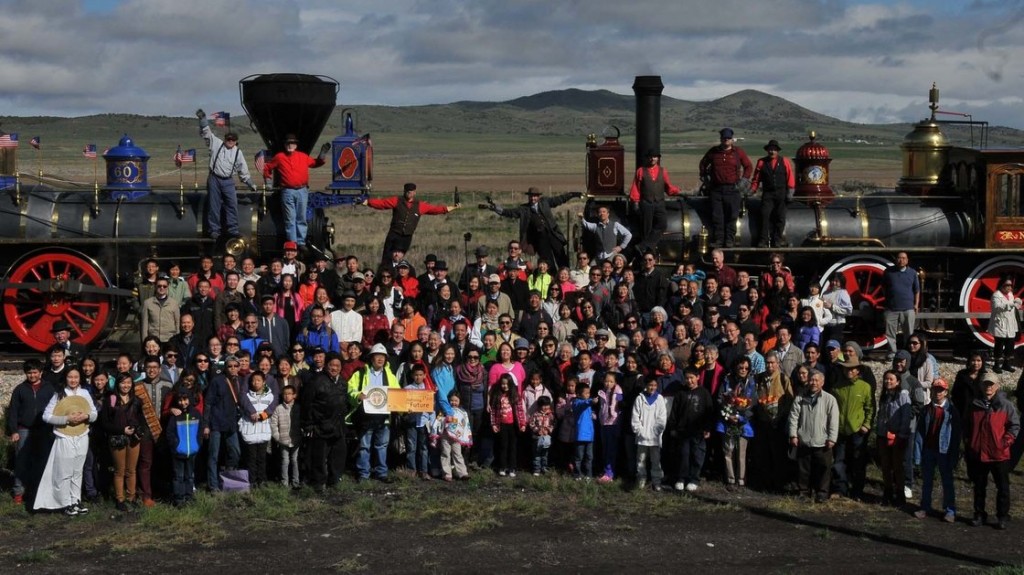Photographer Corky Lee has dedicated much of his life documenting the Asian American experience through photographs. The omission of Chinese from the official photo commemorating the completion of Chinese Americans was one of the motivating factors behind his passion for photography (photo by Corky Lee).
It was Lee who decided a year ago he would organize a group of Chinese Americans to recreate that photo, but only this time with Chinese Americans. As many as 250 Asian Americans came out for the photo with more than 2,000 others looking on from the crowd. Lee agreed to answer a few questions from AsAmNews.
What was your inspiration for your event?
Ever since junior high school I was elated but perplexed why the Chinese laborers were not included in the historic photo on the completion of the Transcontinental Railroad. If the Chinese helped build the railroad, why were they not in the photo? I thought that maybe if I got a magnifying glass, I would be able to count how many there were. My sense of pride was diminished when I realized they were not there, even with a 2nd but larger magnifying glass.
As I began to understand and realized upon doing a term paper in an American history class in college, the Chinese were omitted on purpose. I was thankful that I had my first and only Chinese American professor, Alan Low. I proposed to him that I wanted to do a term paper on the Chinese & the railroad. Needless to say this further intrigued me and I finally went to Golden Spike National Historic Site in Utah in 1972.
Upon arrival the park ranger told me there was a natural rock formation called the “Chinaman’s Arch”and he would give me the key to open the pad locked gate to continue up a dirty road auto tour 4.5 miles from the the site of the last spike. I never heard of the “Chinaman’s Arch” until then, but found out that some 5 years ago local Chinese and Japanese Americans labored to have the name changed to the “Chinese Arch”.
This was the only item that recognized the Chinese laborers because one of the last labor camps was in the immediate vicinity of the arch. I concluded that there is much neglected and forgotten history not only about Chinese Americans and other east Asian Americans, but with Pacific Islander Americans as well. The dominant society is always trying to suppress history.
Why do you think the picture taken 145 years ago at the Golden Spike ceremony struck such a raw nerve with Chinese and Asian Americans?
If the dominant society omits “grains of truth” in a consistent manner over a period of 145 years or more, one always has to question authority and the status quo. 200-250 Chinese,Japanese, Filipino and Chinese nationals traveled thousands of miles to get to Promontory Point, Utah to say “enough is enough.” They committed an “act of photographic justice” denied those 12,000 Chinese laborers 145 years ago.
What do you say to those who might say it was only a picture, get over it?
In a press conference the day before (May 9th, 2014) in the Utah state capital, the mayor of Salt Lake City and the Governor only sent their representatives. To me this was a snub much in the same manner 45 years ago on the 100th anniversary when the then Secretary of Transportation did not allow two founders (Philip Choy & Thomas Chinn) of the Chinese Historical Society of America to present a plaque in a public ceremony.
The Chinese contribution was not acknowledge at all. In the “official” reenactment photo taken in 1969, women in period clothing are included even though women never worked on the railroad 145 years ago, Thus if you include women who were not in the original photo, why not be inclusive and invite Chinese in period clothing who did work on the railroad?
How do you think your event will change perceptions of Chinese and Asian Americans?
I would hope that the dominant society would take notice and realize that they have to be more inclusive in the decision making process. The event has a empowering effect on those Chinese and Asian Americans who attended and will have a ripple effect. I envision that the gathering of APA’s yesterday is like a spark that ignites an prairie fire, the spark will die, but the prairie fire will spread far and wide.
How did others at the Golden Spike anniversary celebration react to your photo recreation?
I’m being given credit for bringing 16 local APA organizations together for the photo event in Golden Spike.
It has given the local community a common thread to organize and build for more inclusion in Utah. The National Park Service has welcomed me to do a photo exhibit in Golden Spike next year. Both Leland Wong, Jook Leung and myself have been asked to do a group exhibit in Salt Lake City to be sponsored by the 16 APA organizations.
Is there anything else you’d like to add?
I will spend the rest of my time trying to photograph Wat Misaka, formerly of the NY Knicks circa 1959….




RE: Corky Lee stages an act of photographic justice for Asian Americans: Please drop the initials “APA,” which some might take as standing for the American Protective Association, a nativist, very anti-Catholic organization of the 1890s. Tantamount to using KKK and saying it stands for something other than the klan. I read APA and think “No Irish Need Apply.” But good luck with the photo, which is a long time coming. I always wondered why there were no Chinese in the original.